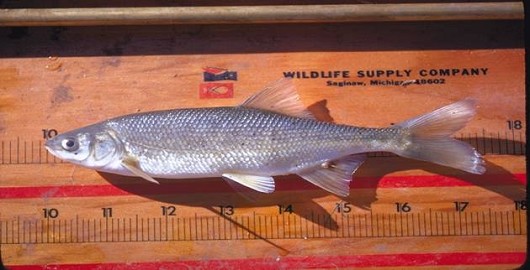Monterey Hitch
-
Scientific NameLavinia exilicauda harengeus
-
NativeYes
-
Identification
 Hitch adult. Photo courtesy of Professor Peter B. Moyle.
Hitch adult. Photo courtesy of Professor Peter B. Moyle.PLEASE NOTE: The photos and information shown here are for the species Hitch, of which the Monterey Hitch is a sub-species.
- Deep, laterally compressed body, may exceed 35 cm SL
- Large scales, small head, upturned mouth
- Narrow caudal peduncle, large anal fin, large forked tail, keel absent
- Brownish yellow back, no spot, progressively darker with age
- Juveniles: silvery, possess spot
- Fin rays: anal 11-14, dorsal 10-13
- Lateral line scales: 54-62 (decurved)
-
Life History
Hitch are most often found in slow warm water, including lakes and quiet stretches of rivers. Hitch are sometimes found in cool and clear, low-gradient streams, hiding among aquatic vegetation in sandy runs or pools. They are the most heat tolerant of the native Central Valley fishes and can withstand water temperatures greater than 30°C under some conditions. They have also been found living in brackish water with salinities as high as 9 ppt. Within a pristine system Hitch often share habitat with Sacramento Blackfish, Sacramento Suckers, and Sacramento Pikeminnows. In altered systems Hitch are found among introduced species like Mosquitofish, Catfish, and Centrarchids. In a stream the Hitch may use its upturned mouth to feed in the water column or to feed on the surface for insects. In a lake Hitch may occupy different spaces depending upon age. Juveniles typically live in shallow vegetated areas near shore, while the older fish (>80 days) live in deeper offshore waters. Young Hitch may shoal for the first two months of residency in a lake. The diet of a limnetic (lake-dwelling) Hitch may include zooplankton, crustaceans, or various forms of insects. Growth rates of Hitch vary depending upon the environmental conditions, though in general females reach sexual maturity in 2-3 years, while males may reach sexual maturity in years 1-3. Spawning typically happens in the tributaries to lakes and rivers, and may begin as early as February and end as late as July. Fecundity in Hitch is relatively high as one female may produce 3,000 to 63,000 eggs, depending upon body size. When spawning adults reach a suitable riffle for breeding one female may be surrounded by 1-5 males. A ripe female releases her eggs into the current and the males immediately fertilize the eggs. The eggs then settle into the gravel substrate where the size of the ova will increase and help lodge it into the rock particles. In 3-7 days the embryos hatch, and 3-4 days after the hatch the embryos begin to swim freely. The young Hitch may swim downstream to a lake or slough, or reside within the stream under the cover of aquatic plants. Hitch generally live for a total of 4-6 years.
-
Links to Other ResearchN / A
